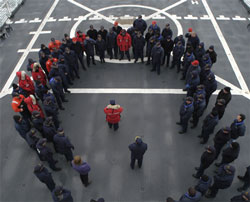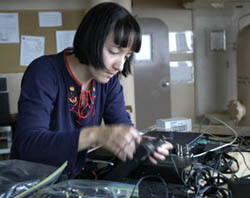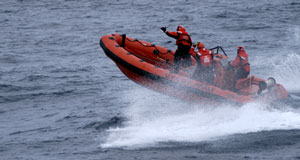 |

|
 |
| Captain Oliver addresses
the ship's crew during quarters, a daily meeting. |
| Click
to enlarge |
Daily Update
Calendar
Dispatch 03 - September 12, 2003
By C. A. Linder
Weather conditions: Overcast skies, 15 kt
winds, 2-3 ft seas, air temperature 32°F
Send in the Cavalry
I'm pretty proud of myself - I didn't get lost today. I can successfully
navigate from my room to the mess deck (where I can find sustenance)
and to the main laboratory (where I can find my computer). Ask me
about any other location in the ship, and you'll get a blank stare.
This ship is huge. At 420' long, it's longer than a football field.
The interior is a maze of passageways (hallways), ladders (stairs),
and compartments (rooms). Healy is the newest Coast Guard
icebreaker, and the most technologically advanced. Due to the many
modernizations, only 70 crew members are required to keep the ship
running -- roughly half the crew size of the other US Coast Guard
icebreakers Polar Star and Polar Sea. Instead
of a noisy and inefficient loudspeaker information system, everyone
carries a pager. For more information
on the Healy, visit our ship
page or the Healy
homepage.
 |
 |
| Lisa Munger sets up her workstation on the bridge. Lisa will be using passive acoustics to listen to marine mammal calls on the cruise. |
| Click
to enlarge |
The science party continued setting up equipment today. On the bridge
(where the crew drives the ship), I found Lisa Munger setting up a
complicated array of tape drives, cables, and other computer equipment.
She has the best view from her "office".
That's because Lisa has to be able to spot whales with her binoculars,
and also listen to the noises those whales are making. To do this
she uses a passive (meaning it doesn't emit any sounds itself) listening
device called a sonobuoy. The buoy is simply a big floating microphone
(called a hydrophone since it listens underwater) that collects all
of the noises it can "hear" and sends them to Lisa as a
radio broadcast. She then records all of these noises on digital tapes
for future analysis. While Lisa was busy on the bridge, David Leech,
a mooring technician from the University of Alaska, Fairbanks was
busy getting ready to recover the first mooring.
This mooring is in Barrow Canyon (it's the star near Wainwright on
this map). The instruments
on the mooring have been collecting data since the mooring was initially
deployed last summer. Last year this proved to be a difficult task
-- our first attempt to put in the mooring was aborted due to a high
concentration of ice (read 2002
Dispatch 10 for details). We had no such problems this year --
Barrow Canyon, like most of the Chukchi Sea, is usually ice-free in
September. The previous winter's ice has melted away, and the temperatures
are not yet cold enough to form new first-year ice. These conditions
make David Leech smile, because he doesn't have to battle the ice
to get his priceless data back. The first step in retrieving a mooring
is to tell the mooring to drop its anchor. We do that with an acoustic
release system. When we're ready to pull out the mooring, we put a
sound source in the water and send a complex series of "chirps"
into the water. When the mooring hears these chirps, it drops the
anchor and floats to the surface. It took a few tries to get the mooring
to hear our chirps today, but eventually the mooring floated right
up to the surface, amid many cheers, within sight of the ship.
 |
 |
| Send in the cavalry - a small boat races toward the recently released Barrow Canyon mooring. |
| Click
to enlarge |
Next, we have to get this equipment back on deck so that David can
retrieve the data that is stored in the instruments. Since the top
float is relatively small, it's too difficult to try to pick it up
directly with the ship's crane. Instead David set out with a Coast
Guard team in a small boat called a zodiac. They shot off through
the waves, sending spray flying. After hooking the mooring floats,
they towed the entire mooring back to
the Healy. Once the zodiac pulled alongside, the team attached
the crane hook to the mooring, and let the crane
lift the delicate instruments out of the water and onto the deck.
Mission accomplished! Now David must extract the data and get the
instruments ready to be redeployed.
Tomorrow the instruments will go back into Barrow Canyon to collect
data for one more year.
 Previous
Dispatch Next Dispatch Previous
Dispatch Next Dispatch

Back to
Calendar
|




